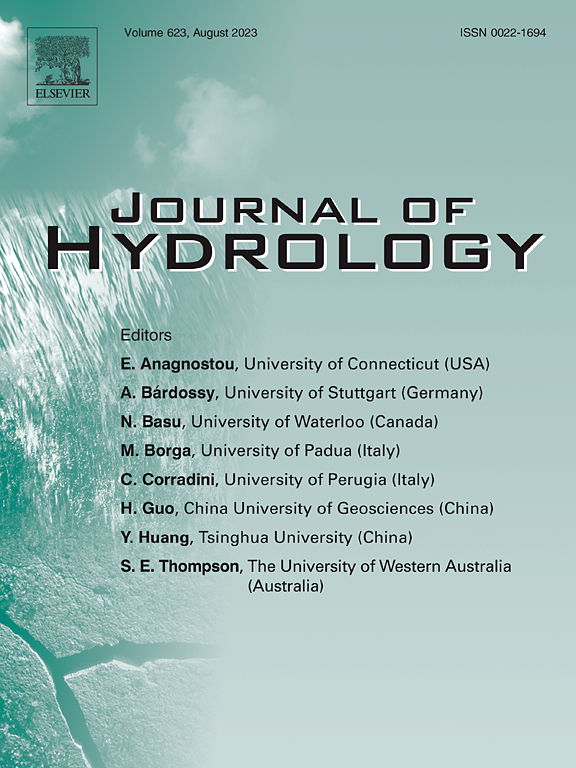Estimating transient vertical hyporheic exchange fluxes from streambed temperatures using LSTM-autoencoder-enhanced physics-informed neural networks
IF 6.3
1区 地球科学
Q1 ENGINEERING, CIVIL
引用次数: 0
Abstract
Accurately quantifying hyporheic exchange fluxes is crucial for understanding the transport and fate of contaminants and nutrients in the hyporheic zone. Over the past two decades, both physics-based analytical and numerical models, as well as data-driven models have been widely employed to infer these fluxes from streambed temperatures. However, each model type has notable limitations: physics-based models can suffer from structural errors that diminish inversion accuracy, while data-driven models often create input–output relationships without adequately considering the constraints imposed by established physical processes. To address these limitations, this study introduces a novel inversion framework termed LSTM-AE-PINN that integrates the physics-informed neural network (PINN) with the long short-term memory-based autoencoder (LSTM-AE) to estimate transient vertical hyporheic exchange fluxes (VHEFs). This framework leverages PINN to merge observational data with scientific principles and uses LSTM-AE to derive a low-dimensional representation of the VHEF time series, thereby streamlining parameter identification. The efficacy of LSTM-AE-PINN is evaluated through two synthetic case studies and one real-world application, demonstrating consistent superiority over PINN. It improves Kling-Gupta Efficiency (KGE) scores for VHEF estimations by 2.31 % to 88.62 %, with greater advantages in sparse or highly uncertain observational scenarios. This advancement not only refines VHEF estimation but also establishes a transferable template for inferring time-dependent parameters in broader hydrological contexts.
利用lstm自编码器增强的物理信息神经网络估计河床温度的瞬态垂直潜流交换通量
准确量化潜流交换通量对于了解潜流带中污染物和营养物的迁移和归宿至关重要。在过去的二十年中,基于物理的分析和数值模型以及数据驱动的模型都被广泛应用于从河床温度推断这些通量。然而,每种模型类型都有明显的局限性:基于物理的模型可能存在降低反演精度的结构误差,而数据驱动的模型通常在没有充分考虑已建立的物理过程所施加的约束的情况下创建输入-输出关系。为了解决这些限制,本研究引入了一种称为LSTM-AE-PINN的新型反演框架,该框架将物理信息神经网络(PINN)与基于长短期记忆的自编码器(LSTM-AE)集成在一起,以估计瞬态垂直下海交换通量(vhef)。该框架利用PINN将观测数据与科学原理合并,并使用LSTM-AE导出VHEF时间序列的低维表示,从而简化参数识别。LSTM-AE-PINN的有效性通过两个综合案例研究和一个实际应用进行评估,显示出优于PINN的一致性。它将VHEF估计的KGE分数提高了2.31%至88.62%,在稀疏或高度不确定的观测场景中具有更大的优势。这一进展不仅改进了VHEF估计,而且还建立了一个可转移的模板,用于在更广泛的水文背景下推断时间相关参数。
本文章由计算机程序翻译,如有差异,请以英文原文为准。
求助全文
约1分钟内获得全文
求助全文
来源期刊

Journal of Hydrology
地学-地球科学综合
CiteScore
11.00
自引率
12.50%
发文量
1309
审稿时长
7.5 months
期刊介绍:
The Journal of Hydrology publishes original research papers and comprehensive reviews in all the subfields of the hydrological sciences including water based management and policy issues that impact on economics and society. These comprise, but are not limited to the physical, chemical, biogeochemical, stochastic and systems aspects of surface and groundwater hydrology, hydrometeorology and hydrogeology. Relevant topics incorporating the insights and methodologies of disciplines such as climatology, water resource systems, hydraulics, agrohydrology, geomorphology, soil science, instrumentation and remote sensing, civil and environmental engineering are included. Social science perspectives on hydrological problems such as resource and ecological economics, environmental sociology, psychology and behavioural science, management and policy analysis are also invited. Multi-and interdisciplinary analyses of hydrological problems are within scope. The science published in the Journal of Hydrology is relevant to catchment scales rather than exclusively to a local scale or site.
 求助内容:
求助内容: 应助结果提醒方式:
应助结果提醒方式:


